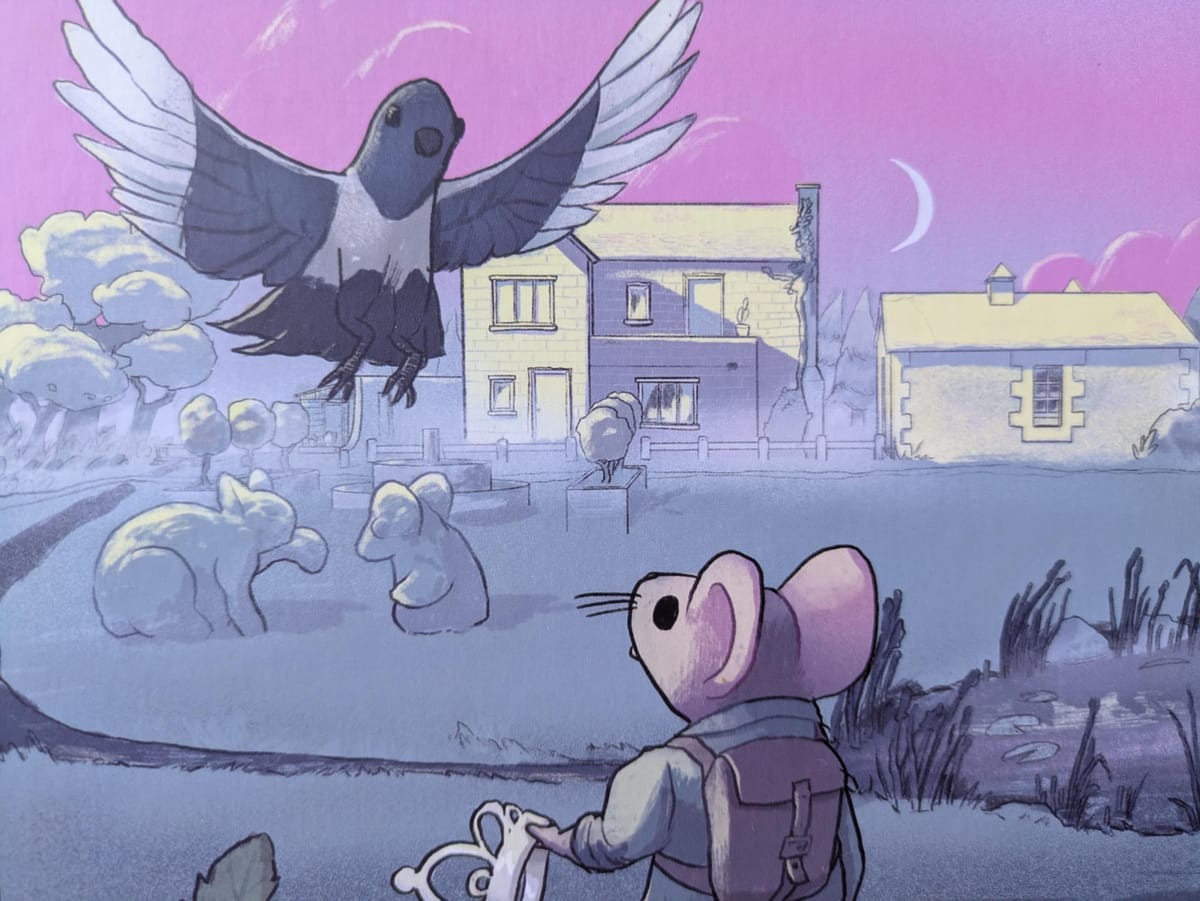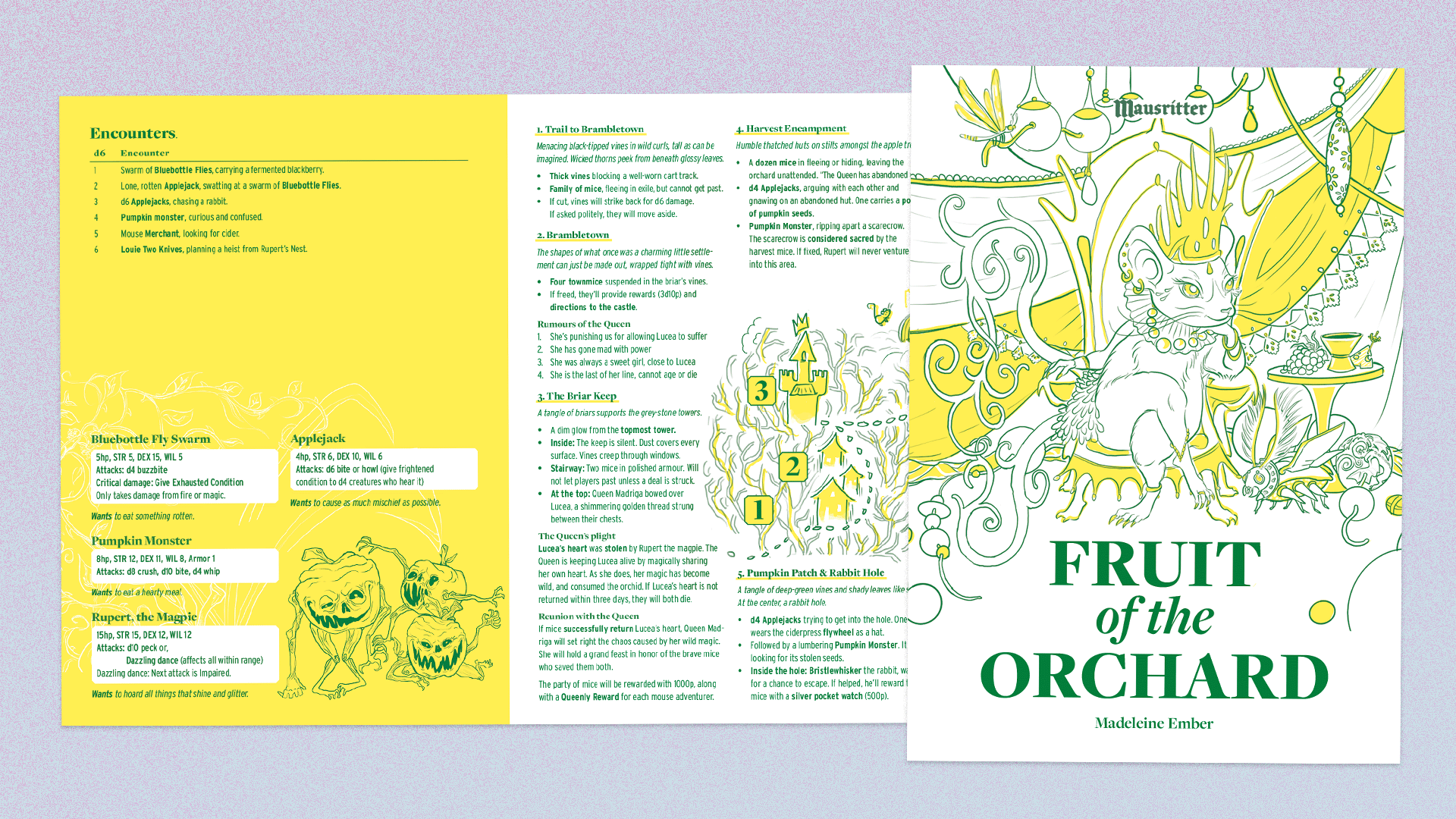
Mausritter impressed me in many ways, its lighter mechanics hiding great consideration for presentation, design, and components. The physical inventory system gives every item extra importance while communicating well to players, and the rules are easy to learn but contain welcome depth for combats, exploration, and faction play. The Estate follows on these trends, working as a set of adventures and a campaign setting all at once. While it shares some of the same issues I raised with Mausritter, i.e., not digging into its own ideas as deeply as I might like, the quality and usability on display remain top-notch. The Estate is a wide expansion of content, if only a minor expansion on the underlying rules.
The boxed set contains the Estate campaign guidebook, 11 adventures (each with their own separate sets of items in cardboard punchouts), a poster/map of the Estate and mouse hub town Brickport, an extra dry erase marker, and three small envelopes to keep your many items in between sessions. Those envelopes are a smidgen flimsy, but that’s my only real complaint about the components. You will end up with a large pile of separate items at the bottom of the box, but the color coding will help alleviate any annoyances that the pile stirs in you. The art remains exceptional, melding quaint country life with a thin layer of horror. Each adventure has its own aesthetic flair and colors to help differentiate them and set the tone.

I have a lot of good things to say about those adventures, but I first need to talk about how intelligently they are delivered to you. The Estate, a large Victorian house and surrounding environs, and each adventure are broken out into separate booklets, really more pamphlets than anything. I can comfortably call this genius. Instead of one large book that you have to flip through and cross-reference (evoking worrisome flashbacks to the nauseating organization that was Curse of Strahd), you have all the information you need for a given adventure in front of you separately. For a one-shot, all you need is a single small pamphlet with all the information you need. At the table, if players explore in a direction you don’t expect, you only have to read a tiny bit, all kept in its own section, to get yourself running. The rules important to the campaign overall are stored in the guidebook, running you through the factions and long-term rules.
The 11 adventures feature an appreciable range of encounter types. Your players could fight their way up a grandfather clock full of mechanical spiders, retrieve a royal crown from a sludge of encroaching fungi, travel downriver as you resolve disputes between frog clans, or uncover the secret machinations of a religious order, among the many options. These adventures offer room for social encounters aplenty, but that shouldn’t distract from the basic fact that these are ultimately dungeon-based combat scenarios. That’s the foundation of the game, and should come as no surprise, but it’s worth keeping in mind as you consider venturing into the Estate.

The overall writing maintains strong conciseness, which mostly benefits the experience. Mostly. I am of the opinion that the vast majority of RPG rules and adventures are overwritten. Too much information over too much text, obscuring important information. The Estate, on the other hand, keeps things concise. You come upon a burning tree. Inside is a town of caterpillars that are worse for wear, with one distraught over her missing brother and a few other small seeds. If you’re new to this, you might be surprised to learn that you really don’t need anything else. Take the seeds, start talking, and you’ll see how quickly your imagination fills in the gaps. Mausritter will help make better GMs because it understands what information you need and what you can be trusted to make up on your own. It makes the adventures easy to prep, effortless to run, and almost as easy to string together. Almost.
As much as I appreciate the Estate’s structure, the one area where it lacks some finesse is making its many adventures cohesive as a campaign. The faction rules are good, and sometimes they feature directly into the adventures, but the area most prone to throwing new GMs off will be integrating them into the story and building the campaign into a long-term story. The adventures are generally disconnected from one another, but those factions are the building blocks to a longer game. Apart from one or two options you might make work, there’s nothing like a climax or focal thrust to the overall experience. A series of adventures is great on its own, but I do think you’ll lose steam somewhere along the line unless you can finagle an independent way to give the campaign a sense of direction.
Also, while it’s nice that there are many items here for these adventures, I found myself wishing the adventures experimented more with Mausritter’s physical inventory system. There is some exploration, rest assured. You can get webbed, covering your items, and needing actions to clear. There are some permanent fungal features attached to your character that are cool and extremely thematic. I recall one condition that covers you in slime, which marks usage on worn items, but no interaction past that. It just happens. One monster might set your items on fire, but without notes on what that means exactly.

The equipment all have the same number of uses and they don’t experiment with shape or swapping mechanics, but I can acknowledge that those are generally minor complaints. It’s a little more worrisome how many your party will be loaded down with over the course of the adventure. Some items have helpful descriptive text, but many are just small drawings with usage slots. The game primarily communicates through items, be they spells, equipment, or conditions. Some of these are interesting, but there are a LOT of them. You’ll be so overloaded with options that many of them will quickly become trivial, even potentially interesting ones.
The adventures will run a good session, maybe less, but with the connective tissue and usability of options, $55 feels very reasonable for the physical edition.
Mausritter: The Estate boxed set
Great
The Estate is a smart, generous expansion to Mausritter, marrying elegant design with a trove of modular, easy-to-run adventures. Its physical components and pamphlet-style structure make prepping and playing a joy, even if the campaign lacks a strong overarching narrative. While it misses some opportunities to deepen interaction with its inventive inventory system, the overall experience remains rich, evocative, and highly accessible. For $55, it’s a well-crafted toolkit that invites creativity and rewards improvisation.
Pros
- Tons of material from the adventures and items
- Easy to run as short adventures or a medium campaign
- Good variety of adventure types
Cons
- Not enough rules expansion
- Could use more advice for cohesion
- Too many items to practically use
This review is based on a retail copy provided by the publisher.
